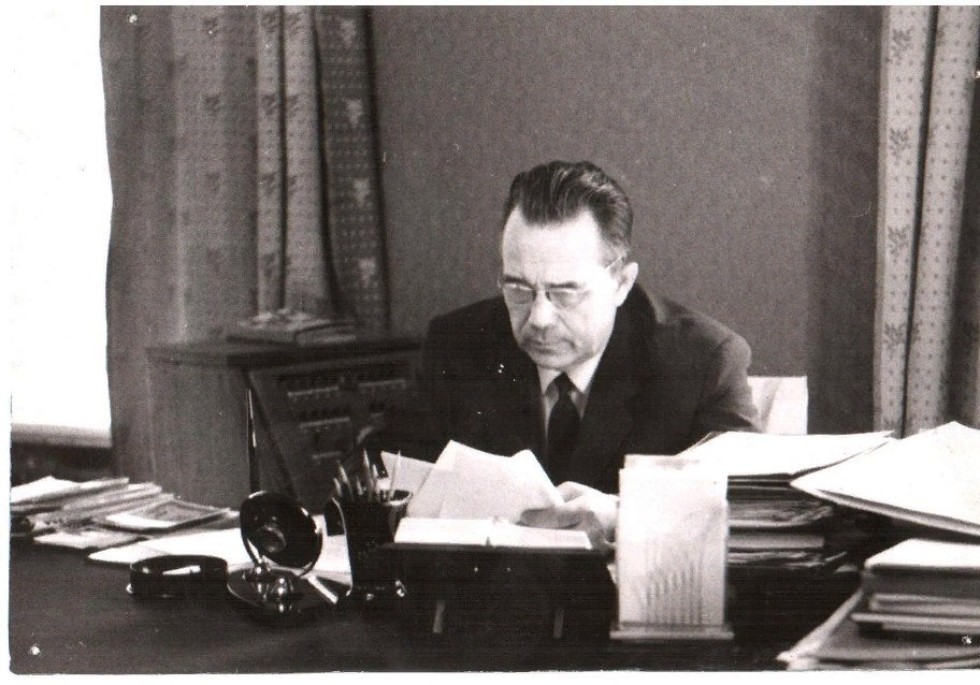Mikhail Nuzhin – from student to longest-serving Rector of Kazan University

Mikhail Nuzhin (1914 – 1983) made immense contributions to the growth of Kazan State University (KSU) in the 20th century; he served in the top position from 1954 to 1979.
After graduating from Kazan University in 1938 with a degree in the theory of elasticity, Nuzhin immediately enrolled in a PhD course – but was conscripted to the Red Army in December 1939. He was commissioned to Mongolia, where the Soviet forces had just decisively defeated the Japanese Empire’s army. Until February 1942, the future rector worked as a plane mechanic and taught at a local Communist Party course in political science.
Nuzhin was then directed to Chernigov Army School – which was at that time already evacuated to Irkutsk in Siberia. After graduating with the rank of political commander, he was drafted to the 831st Artillery Regiment of the 279th Division. He spent all his time there from June 1942 to the victory in May 1945. Nuzhin was decorated with two Orders of the Red Star and one Order of the Patriotic War, 1st Degree. The scientist met the long-awaited victory as the Communist Party Organizer of the 831st Regiment.
In June 1946, after serving a short stint in the Ural Military District, Nuzhin returned to his studies and presented a PhD thesis in June 1947 – his topic were inverse boundary value problems and their applications to the theory of elasticity.
Nuzhin was then employed as Senior Research Associate and since October 1951 – Head of the Section of Mechanics of the Chebotaryov Research Institute of Mathematics and Mechanics, a subsidiary of Kazan State University. Among his lecture courses were Analytical Mechanics and Elements of the Theory of Elasticity, Theory of Analytical Functions, Inverse Boundary Value Problems and their Applications to Mechanics, and others.
In September 1952, Nuzhin moved to Moscow State University to complete his second doctorship (DSc); he defended his thesis ‘Inverse boundary value problems of the theory of analytical functions and their applications to mechanics’ in 1954 at the same institution.
The researcher was then elected to head a newly opened Department of Theoretical Mechanics at KSU. By 1963, over 35 theses were presented at the University, and the Kazanian school of boundary value scientists became known in the nation and in the world.
Nuzhin’s successes as a leader were noticed, and he was appointed Rector of KSU on 16 June 1954. The University then comprised 7 faculties and 20 specialties; there were 316 educators and several dozen research associates. The University counted 3,500 students.
The postwar difficulties were still much felt at the time – old buildings needed renovation, students didn’t have enough living space in dorms, there was a clear need for new facilities, and, most importantly, for lab equipment and devices. Nuzhin was very energetic in dealing with all the problems, especially in improving the infrastructure for physics and mathematics.
In 1960, the Faculty of Physics and Mathematics was divided into the Faculty of Physics and the Faculty of Mathematics and Mechanics. The physicists were very lively in their commercial research for the government and the industry and were able to use the revenue to further improve the infrastructure. The Faculty grew fast, and between 1960 and 1980 over 250 dissertations were defended.
With such a steady growth, the Faculty of Physics became the most sizable. Mathematicians also trod new ground in cybernetics, probability theory, statistics, and applied mathematics.
With that, the student body was also growing rapidly. In 1961, there were 5,989 students, in 1966 – 8,922, in 1970 – 9,510. The number of teaching staff grew from 584 in 1966 to 867 in 1979.
In 1958, KSU’s Publishing House was established; it issued hundreds of books during Nuzhin’s tenure, as well as many periodicals.
Naturally, the increases in numbers also led to new construction. In November 1958, the southern portion of the Main Building – now housing the leadership’s offices – was completed; at that time, it comprised a gym and administrative rooms. In 1966, Nuzhin successfully lobbied a massive expansion project – new study buildings, dorms, and a residential building for employees.
In 1973, the first of twin high-rises – the physics building – was completed. In 1977, the same happened for the Second Building across the street. The combined premises of the two towers are 34,000 square meters. The Second Building also has an adjacent library facility. Among other openings were a mathematical and computing center on Popova street (1970), a cryogenic lab, an astronomical observatory in Karachaevo-Cherkessia in the Russian Caucasus, and a polar meteorology station in Murmansk Oblast. Apart from that, five dormitories (now known as KFU’s Student City) were erected in the city center, and the number of beds rose from 1,920 to 3,470. Nuzhin’s immense expansion endeavors were akin to those of another famous leader, Nikolay Lobachevsky, who served as rector between 1827 and 1846.
Mikhail Nuzhin also served as Member of the Supreme Soviet of the Russian Soviet Federative Socialist Republic in 1959 – 1967 and contributed to educational legislation. He was named Distinguished Worker of Science of RSFSR in 1964. For his achievements in labor, the productive rector was awarded the Order of Lenin, the Order of the October Revolution, the Order of the Red Banner of Labor, and the Order of the Friendship of Peoples.
In 2004, a bust and a memorial plaque to Nuzhin were installed in the central campus in Kazan. Two streets in the city are named after him – Ulitsa Professora Nuzhina near the Main Building (where some of KFU’s facilities are located) and Proyezd Professora Nuzhina in the southern part of Kazan (where KFU’s Bustan Sports Complex is situated).

